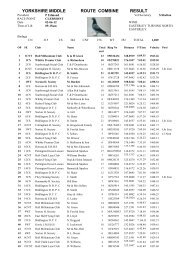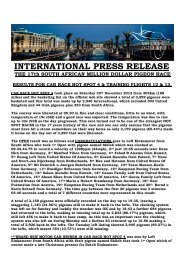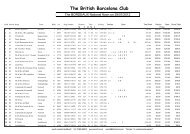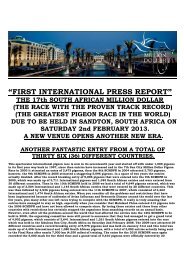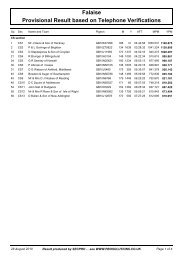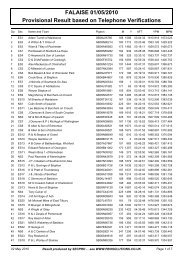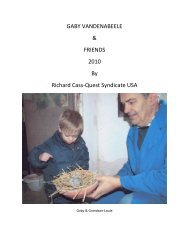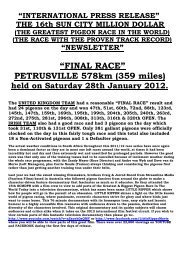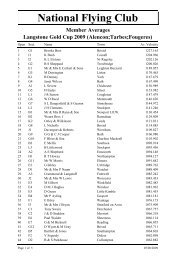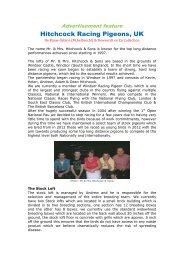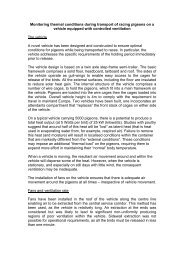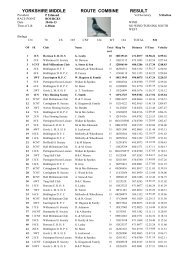Taking to the skies - Elimar Pigeon Services
Taking to the skies - Elimar Pigeon Services
Taking to the skies - Elimar Pigeon Services
You also want an ePaper? Increase the reach of your titles
YUMPU automatically turns print PDFs into web optimized ePapers that Google loves.
The wing of <strong>the</strong> racing pigeon is no different from any o<strong>the</strong>r part of this racingmachine, which is generally developed <strong>to</strong> perfection. There have been many <strong>the</strong>oriesover <strong>the</strong> years and through extensive breeding <strong>to</strong> near perfection of <strong>the</strong> distance that<strong>the</strong> pigeon is required <strong>to</strong> fly. Experienced fanciers have bred pigeon’s for <strong>the</strong>irpreference in racing i.e. <strong>the</strong> wing for <strong>the</strong> sprinter or which in <strong>the</strong> modern day of racingcan be anything up <strong>to</strong> 300mls. In my early days of racing pigeons this distance wasclassed as middle distance but with <strong>the</strong> improved knowledge gained by <strong>the</strong> observantfancier <strong>the</strong> sprint distance has been increased. This also applies <strong>to</strong> <strong>the</strong> middledistance of 300 <strong>to</strong> 500mls; <strong>the</strong>se races have been covered by more and morepigeon’s yearly. In fact if you do not clock on <strong>the</strong> day from 450 <strong>to</strong> 500mls <strong>the</strong>n it isconsidered that <strong>the</strong>re is something wrong.The long distance races are upwards of 500mls where <strong>the</strong> numbers clocked areconsiderably reduced unless you get favourable conditions even so <strong>the</strong>re arefancier’s who clock from such distances with a greater degree of regularity. After600mls we are practically always looking at second day birds and again unless <strong>the</strong>reare favourable conditions. Even <strong>the</strong>n <strong>to</strong> compete <strong>to</strong>wards 700mls on <strong>the</strong> day is nomean fete because <strong>the</strong>y still have <strong>to</strong> put <strong>the</strong> time on <strong>the</strong> wing. We know that <strong>the</strong>Central Sou<strong>the</strong>rn have this idea of “At dawn we go”. But in reality <strong>the</strong>re are very fewpigeon’s that will do that kind of distance on <strong>the</strong> day from such places as Pau even <strong>to</strong><strong>the</strong> South Coast where <strong>the</strong>y are covering a band of 500 <strong>to</strong> 525mls <strong>to</strong> <strong>the</strong> shorterflying members. The only problem with <strong>the</strong> pigeons arriving at <strong>the</strong> coast late at nightis will <strong>the</strong>y or won’t <strong>the</strong>y attempt <strong>to</strong> cross <strong>the</strong> water. I have very often thought of howmany pigeons try <strong>to</strong> make it across <strong>the</strong> water late at night and fail <strong>to</strong> reach <strong>the</strong>irdestination. One thing that you must remember about distance racing is <strong>the</strong>preparation and <strong>the</strong>re are not great numbers of pigeon fanciers who can prepare<strong>the</strong>m for 600/700ml races. This is where <strong>the</strong> good pigeon comes in<strong>to</strong> its ownbecause no matter how much work you put in<strong>to</strong> <strong>the</strong> pigeons not many will keep goingover such a distance. Top class sprint pigeons will rarely do <strong>the</strong> distance because<strong>the</strong>y put everything in<strong>to</strong> <strong>the</strong> opening of a race and <strong>the</strong>y will give everything and <strong>the</strong>get tired. Then when <strong>the</strong>y get <strong>to</strong> <strong>the</strong>ir maximum distance <strong>the</strong>y go down and find ithard <strong>to</strong> get going again so do not return <strong>to</strong> <strong>the</strong>ir home loft.Most of <strong>the</strong> racing done in Britain is on land based on <strong>the</strong> fact that for <strong>the</strong> majority offancier’s <strong>the</strong>re are good races without crossing <strong>the</strong> water. Obviously depending onwhere your loft is situated you can get a couple of hundred miles plus on ei<strong>the</strong>r Northor South road points. For those fanciers living in <strong>the</strong> central part of <strong>the</strong> Country <strong>the</strong>racing is good because <strong>the</strong>y can get a good land race before crossing <strong>the</strong> channelwhich <strong>the</strong>y <strong>the</strong>n get in <strong>the</strong> last two thirds of <strong>the</strong> race. Now for <strong>the</strong> Sou<strong>the</strong>rn fancierswho want <strong>to</strong> race <strong>the</strong> Nationals it is unfortunate that <strong>the</strong>y have <strong>to</strong> get <strong>the</strong>ir birdsacross <strong>the</strong> water early in <strong>the</strong>ir races if <strong>the</strong>y are <strong>to</strong> succeed in <strong>the</strong> big races. We weredown at <strong>the</strong> Blandford lofts of Tony Haynes a few years ago for a Guernsey race andcould not believe <strong>the</strong> problems that <strong>the</strong> Sou<strong>the</strong>rn fanciers have from such a shortrace. Where you are situated in <strong>the</strong> country does make a big difference <strong>to</strong> <strong>the</strong> resultsthat you are going <strong>to</strong> achieve. Always remember that <strong>the</strong>re is nothing fair aboutracing pigeons because <strong>the</strong> position and wind will always dictate <strong>the</strong> winners. That iswhy when you are selecting where you are going <strong>to</strong> by you pigeons from you musttake everything in<strong>to</strong> account.What we must remember is that <strong>the</strong> velocity of a particular race will also have abearing on <strong>the</strong> winners as will <strong>the</strong> wind which is why so much must be taken in<strong>to</strong>account when you are preparing pigeons for sprint, middle or long distance races.Why should this be, well on a hard day with <strong>the</strong> vels dropping <strong>to</strong> 1000ypm or evenless we generally find that <strong>the</strong> fanciers who do well in <strong>the</strong> longer events are higher up
<strong>the</strong> result sheet? That makes a big difference <strong>to</strong> <strong>the</strong> way we pair <strong>the</strong> pigeons andthat is why we should be very selective with our choice. We must never make <strong>the</strong>mistake of rating a pigeon as an all rounder on <strong>the</strong> strength of one win in <strong>the</strong> longerevents if it has a proven track record on land but never raced across. If you do classa pigeon as an all rounder <strong>the</strong>n you must take in<strong>to</strong> account <strong>the</strong> vels on <strong>the</strong> day aswell as <strong>the</strong> distance covered. You can get sprint <strong>to</strong> middle distance pigeons coveringgreater distances but that nearly always happens when <strong>the</strong> wind is in <strong>the</strong>ir favour andif <strong>the</strong> conditions are against <strong>the</strong>m <strong>the</strong>y more often that not go down. It is a fact thatsome fanciers north of <strong>the</strong> Midlands will not put a pigeon in<strong>to</strong> a channel race that hasa good track record in <strong>the</strong> land races with some pigeons this is wise because <strong>the</strong>pigeon may only be built for sprint races in <strong>the</strong> first place and <strong>the</strong> wing <strong>the</strong>ory will tellyou that this pigeon is not going <strong>to</strong> make <strong>the</strong> distance.So what have we picked up so far with <strong>the</strong> wing <strong>the</strong>ory, <strong>the</strong> main point beingconsideration <strong>to</strong> <strong>the</strong> conditions of <strong>the</strong> day? I remember winning a 120ml race when Iwas working at Foden Trucks Sandbach and every weekday lunchtime we would sitaround and have an inquiry about all sorts of things. One Monday in <strong>the</strong> early days Iwent in as pleased as punch because I had won <strong>the</strong> race on <strong>the</strong> Saturday that wasuntil <strong>the</strong> late George Stubbs pulled me up saying that you cannot class a pigeon asbeing good after winning in a tail wind. That point brings us back <strong>to</strong> <strong>the</strong> wing <strong>the</strong>oryand which wing suits which distance. Because no matter how much <strong>the</strong> commenthurt at <strong>the</strong> time he was right and it makes you wonder just how much some of <strong>the</strong> <strong>to</strong>pfanciers actually know and keep <strong>to</strong> <strong>the</strong>mselves. Ano<strong>the</strong>r fancier who pointed me in<strong>the</strong> same direction was Roy Smith who could always be seen in <strong>the</strong> results when itcame <strong>to</strong> <strong>the</strong> channel races. By this time I was ga<strong>the</strong>ring more and more informationabout what was required <strong>to</strong> win a good race in comparison <strong>to</strong> a race when <strong>the</strong>elements were favouring <strong>the</strong> pigeons as <strong>the</strong>y soared <strong>to</strong>wards <strong>the</strong>ir home.When you are just starting out in <strong>the</strong> world of racing pigeons it is hard <strong>to</strong> take whatyou consider are unfavourable comments when you have just won a few prizes in <strong>the</strong>early years. Not in all cases but most of those comments are worth taking in<strong>to</strong>account but do not get <strong>the</strong> comments from a good distance winning fancier mixedwith those of <strong>the</strong> jealous fancier who does not want <strong>to</strong> see you winning in <strong>the</strong> moreprestige’s races. Those are generally <strong>the</strong> fanciers who have tried it and failedmiserably and gone back <strong>to</strong> <strong>the</strong> easier sprint races. I say easier, <strong>the</strong>y are but youhave <strong>to</strong> put more work in<strong>to</strong> winning those races. Training and good exercise is <strong>the</strong>name of <strong>the</strong> game in <strong>the</strong> sprint events whereas <strong>the</strong> distance races need patience andknowledge.This is where <strong>the</strong> fancier who knows and studies <strong>the</strong> wing of <strong>the</strong> pigeon comes in<strong>to</strong><strong>the</strong>ir own. Let’s look at what we need; first of all you need <strong>the</strong> right breeding forwhatever distance you are aiming for. You can <strong>the</strong>m look at <strong>the</strong> winners in thoselines and if <strong>the</strong>y are <strong>to</strong> <strong>the</strong> requirements of <strong>the</strong> chosen distance <strong>the</strong>n you are on <strong>to</strong> awinner. However you might say that <strong>the</strong>re are an awful lot of National performancepigeons that are not directly off <strong>to</strong>p winners but <strong>the</strong>y can and very often do throwback <strong>to</strong> winning descendants. You may have two or three generations where <strong>the</strong>reare no winners but sure as houses are house a <strong>to</strong>p winner will pop up throughselective breeding. Most of this is a reference <strong>to</strong> <strong>the</strong> distance races because if youget a good winning sprint family <strong>the</strong>re are generally several generations of <strong>the</strong>m. Youwill also find that this will s<strong>to</strong>p when <strong>the</strong>y get in<strong>to</strong> <strong>the</strong> hands of a fancier who is notreally as good as <strong>the</strong> previous fancier. The winning family <strong>the</strong>n comes <strong>to</strong> a halt and afew generations are bred because <strong>the</strong>y off such and such a fancier who woneverything <strong>the</strong>y had a go at in <strong>the</strong> sprint races.
A prime example of a good line is that of “Nationaal I” because <strong>the</strong>re are at least 7 x1 st National winners coming from his line in a comparatively short period of time.What’s more a descendant “Nationaal II” who is himself a 1 st National winner iscurrently <strong>the</strong> best breeding cock in Europe if not <strong>the</strong> world and is sought after bysome of <strong>the</strong> <strong>to</strong>p lofts in <strong>the</strong> world. Not all pigeons from this or in fact any line aregoing <strong>to</strong> be winners but on percentage “Nationaal I” has got <strong>to</strong> rate as good as anyand probably far better than most. I shall include <strong>the</strong> wing of “Nationaal II” and acouple of his direct children <strong>to</strong> show how <strong>the</strong>y follow on.Picture 1.Dark Hen winner of prizes <strong>to</strong> nearly 500mls and has been twice 2 nd Niort. This is a fullwing <strong>to</strong> race <strong>the</strong> middle distance where <strong>the</strong> strength of both <strong>the</strong> full wing and <strong>the</strong>strong flights easily propel <strong>the</strong> bird forward. Take note of <strong>the</strong> full back wing and also<strong>the</strong> width of <strong>the</strong> flights right through <strong>the</strong> wing. The end flights become slightly shorterfor <strong>the</strong> middle distance pigeon.
Picture. 2.Is a sprint wing and when <strong>the</strong> pigeon was tested at 300mls he <strong>to</strong>ok ra<strong>the</strong>r longer <strong>to</strong>come home and was not sent <strong>to</strong> a channel race after that? However when you senda pigeon across <strong>the</strong> water that is not suited <strong>to</strong> and distance it does take it out of <strong>the</strong>bird for future sprint events. But for <strong>the</strong> sprint races this cock gained many goodpositions in club and fed. On my travels I have found that this is generally <strong>the</strong> type ofwing that picks up speed. If you look at <strong>the</strong> wing of <strong>the</strong> Sparrow Hawk you will noticethat <strong>the</strong> back wing is very small and even <strong>the</strong> primary flights taper off much morequickly than most o<strong>the</strong>r members of <strong>the</strong> bird family. Take note that <strong>the</strong> primary flightsbecome proportionally longer for <strong>the</strong> sprint pigeon compared <strong>to</strong> <strong>the</strong> middle and longdistance birds.Picture 3.This is a wing that will put any bird up amongst <strong>the</strong> winners up <strong>to</strong> 400 <strong>to</strong> 450mls butwill <strong>the</strong>n drop away, this cock has won prizes in club, fed and Classic up <strong>to</strong> 410mls. Ithas a good back wing that is slightly bigger than <strong>the</strong> out and out sprinters and willrace in any velocity. Notice <strong>the</strong> step up from primary seven <strong>to</strong> eight and also <strong>the</strong>slight gaps between <strong>the</strong> end four flights, this can be found in <strong>the</strong> sprint and middledistance pigeons.
Picture 4.The wing of <strong>the</strong> out and out distance pigeon which has a complete full back wing <strong>to</strong>make flight that much easier for <strong>the</strong> bird <strong>to</strong> stay in <strong>the</strong> air for long periods of time.This type of pigeon does not have <strong>to</strong> put in <strong>the</strong> same number of wing beats <strong>to</strong> cover<strong>the</strong> distance when <strong>the</strong>y have a long journey. The bigger back wing does make iteasier for any bird <strong>to</strong> stay in <strong>the</strong> air with ease. If you look at <strong>the</strong> birds that soar highabove in search of food such as <strong>the</strong> eagles, vultures, buzzards etc <strong>the</strong>y all have bigback wings which effectively keeps <strong>the</strong>ir use of energy <strong>to</strong> a minimum. When you lookat <strong>the</strong> birds that fly long distances in migration <strong>the</strong>y all have big back wings incomparison <strong>to</strong> <strong>the</strong>ir body. In <strong>the</strong> pigeon world we have fanciers who have apreference <strong>to</strong> distance racing and <strong>the</strong>y breed for that purpose which leads <strong>to</strong> this typeof full wing. <strong>Pigeon</strong>s, like birds that are migrating know that geologically <strong>the</strong>y have abig task ahead of <strong>the</strong>m with <strong>the</strong> distance that <strong>the</strong>y have <strong>to</strong> cover and <strong>the</strong>refore <strong>the</strong>ydo not put all <strong>the</strong> energy in<strong>to</strong> <strong>the</strong> faster wing beat. The problem that <strong>the</strong> pigeon haswith flight is that it is a high cost of energy, which is why <strong>the</strong> sprinter who puts in <strong>the</strong>faster wing beats cannot cover <strong>the</strong> longer distance races. I was once in conversationwith a local fancier about one of his pigeons and <strong>the</strong> wing <strong>the</strong>ory and <strong>the</strong> term cameup “Chicken Wing” and that proved <strong>to</strong> be his best 500ml pigeon, again <strong>the</strong> full backwing that a pigeon needs <strong>to</strong> cover greater distances.
The next four are of 1 st National winner “Dark Destroyer” and three of his children thatare crossed with different pigeons. This is a fine example of breeding from a pigeonwith pigeons from o<strong>the</strong>r distances.Picture. 5.Is 1 st National F.C winner “Dark Destroyer” where you can see that <strong>the</strong> back wing is alittle over 300mls but with <strong>the</strong> breeding being Janssen cross Jan Aarden Black giantthis cock is ideal <strong>to</strong> cross in<strong>to</strong> Sprint, Middle Distance and long distance lines.
Picture 5a.Is a blue pied hen off “Dark Destroyer” when he was crossed with a sprint Van ReetHen. This pigeon is spot on <strong>to</strong> cross in<strong>to</strong> <strong>the</strong> sprint Van Reet linesPicture 5b.This is ano<strong>the</strong>r out of “Dark Destroyer” crossed with <strong>the</strong> Middle Distance lines thatwill cross well in<strong>to</strong> and distance pigeon.
Picture 5c.Is an out and out distance line that will win at <strong>the</strong> distance and with <strong>the</strong> balance of <strong>the</strong>wing that will cross ei<strong>the</strong>r way.
We now go on<strong>to</strong> “Nationaal II” who is probably <strong>the</strong> best current day breeding pigeonin Europe being responsible for many <strong>to</strong>p winning pigeons on <strong>the</strong> continent.Picture 6.This is “Nationaal II” himself and has a very good 400mls plus distance wing hatwould quite easily make 500mls. This cock is a 1 st National winner and has bredmany winners including a 1 st National winner against over 72,000 birds. This cockhas bred pigeons via Ferdy Vandersanden <strong>to</strong> win for many of <strong>the</strong> <strong>to</strong>p fanciers inBelgium and also <strong>the</strong> National winner in Holland.
Picture 6a.This is a daughter of “Nationaal II” and is on <strong>the</strong> same line as her sire because <strong>the</strong>sire is also based on <strong>the</strong> same distance.Picture 6b.Ano<strong>the</strong>r daughter of “Nationaal II” but will not quite get <strong>the</strong> same distance as her sirebecause <strong>the</strong>re is an influence of 300/400ml from <strong>the</strong> dams side.



